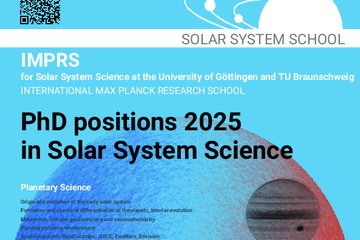All genres
101.
Journal Article
High-precision photometry by telescope defocusing - III. The transiting planetary system WASP-2 star. Mon. Not. Roy. Astron. Soc. 408 (3), pp. 1680 - 1688 (2010)
102.
Conference Paper
A Global Robotic Telescope Network for Time-Domain Science. In: IAU Symposium, pp. 408 - 410. (2012)
103.
Talk
Rosetta and Comet Composition of Volatile and Refractories in the Nucleus of 67P/Churyumov-Gerasimenko. DPS meeting #48, Pasadena, USA (2016)
104.
Talk
The Rosetta mission: Clues on the origin of comet nuclei. DPS meeting #48, Pasadena, USA (2016)
105.
Talk
Physical interrelation of volatile and refractories in a cometary nucleus. DPS meeting #48, Pasadena, USA (2016)
106.
Talk
Rosetta at 67P: what we have learned about cometary activity. DPS meeting #48, Pasadena, USA (2016)
107.
Talk
Determination of an upper limit for the water outgassing rate of main-belt comet P/2012 T1 (PANSTARRS). European Geosciences Union General Assembly, Vienna, Austria (2015)
108.
Talk
Castalia - A Mission to a Main Belt Comet. Conference on Spacecraft Reconnaissance of Asteroid and Comet Interiors, Tempe, Arizona, USA (2014)
109.
Talk
mpact Simulations on the Rubble Pile Asteroid (2867) Steins. DPS meeting #46, Tucson, AZ, USA (2014)
110.
Talk
Determination of an upper limit for the water outgassing rate of the main-belt comet P/2012 T1 (PanSTARRS). Asteroids, Comets, Meteors, Helsinki, Finland (2014)
111.
Talk
The activity cycle of 67P/Churyumov-Gerasimenko. Asteroids, Comets, Meteors, Helsinki, Finland (2014)
112.
Talk
Jets and sources of activity on 67P observed by OSIRIS. EuroPlanet Science Congress, Cascais, Portugal (2014)
113.
Poster
Castalia - A Mission to a Main Belt Comet. Conference on Spacecraft Reconnaissance of Asteroid and Comet Interiors, Tempe, Arizona, USA (2015)
114.
Poster
Comet ISON - From Craddle To Grave, The Approach Phase The Perihelion Passage. Frühjahrstagung der Deutschen Physikalischen Gesellschaft, Arbeitsgemeinschaft Extraterrestrische Forschung e.V., Berlin, Germany (2014)
115.
Poster
Comet ISON from cradle to grave. Asteroids, Comets, Meteors, Helsinki, Finland (2014)











